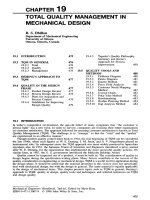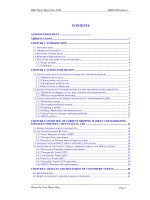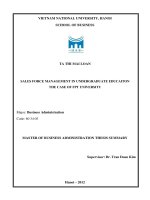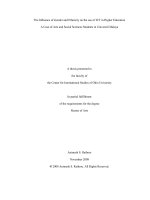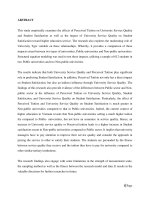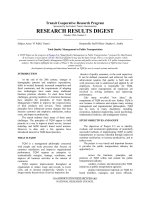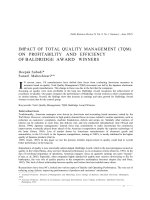Total quality management in higher education a case of international university vietnam national university HCMC
Bạn đang xem bản rút gọn của tài liệu. Xem và tải ngay bản đầy đủ của tài liệu tại đây (3.78 MB, 278 trang )
TOTAL QUALITY MANAGEMENT IN HIGHER EDUCATION – A CASE OF
INTERNATIONAL UNIVERSITY – VIETNAM NATIONAL UNIVERSITY – HCMC
In Partial Fulfillment of the Requirements of the Degree of
MASTER OF BUSINESS ADMINISTRATION
In Finance
By
Ms: Nguyen Ho Thanh Tam
ID: MBA02030
International University - Vietnam National University HCMC
September 2013
TOTAL QUALITY MANAGEMENT IN HIGHER EDUCATION – A CASE OF
INTERNATIONAL UNIVERSITY – VIETNAM NATIONAL UNIVERSITY – HCMC
In Partial Fulfillment of the Requirements of the Degree of
MASTER OF BUSINESS ADMINISTRATION
In Finance
By
Ms: Nguyen Ho Thanh Tam
ID: MBA02030
International University - Vietnam National University HCMC
September 2013
Under the guidance and approval of the committee, and approved by all its members, this
thesis has been accepted in partial fulfillment of the requirements for the degree.
Approved:
---------------------------------------------Chairperson
---------------------------------------------Committee member
---------------------------------------------Committee member
--------------------------------------------Committee member
--------------------------------------------Committee member
--------------------------------------------Committee member
Acknowledge
To complete this thesis, I have been benefited from many people. First of all, I
would like to express my deepest acknowledge to my advisor, Assoc. Prof. Ho Thanh
Phong for being my teacher, my advisor and guiding me through this research with valuable
advices and recommendations. Moreover, he teaches me not only to finish this thesis but also
to know method of applying the content to my current career.
I would like to express my sincere appreciation to Dr. Nguyen Van Chung –
Vice Rector of International University, Dr. Phan Viet Hoang – visiting lecturer of School of
Computer science & Engineering, my colleagues at Office of Academic affairs, Office of
Human Resource Management, and Quality Assurance Center helping me to design
questionnaires and be eager to send information for my research.
My thanks also go to respondents of the surveys who shared their busy time to
answer my questionnaires, and to my friends, Nguyen Ngoc Dieu Thi, Ho Huu Tien, and
Le Duc Phuc for their helps.
To my family, I wish to express all my loving thanks to my dad, sister, and
younger brother to love and encourage me whenever I feel tired, to my died mother for all
her love to me.
Finally, I would like to give many thanks to many people cared for me that listing
names is not enough.
i
Plagiarism Statements
I would like to declare that, apart from the acknowledged references, this thesis either
does not use language, ideas, or other original material from anyone; or has not been
previously submitted to any other educational and research programs or institutions. I fully
understand that any writings in this thesis contradicted to the above statement will
automatically lead to the rejection from the MBA program at the International University –
Vietnam National University Ho Chi Minh City.
ii
Copyright Statement
This copy of the thesis has been supplied on condition that anyone who consults it is
understood to recognize that its copyright rests with its author and that no quotation from the
thesis and no information derived from it may be published without the author’s prior
consent.
© Nguyen Ho Thanh Tam/ MBA02030/2012 - 2013
iii
Table of content
CHAPTER I – INTRODUCTION......................................................................................1
1.
Rationale ....................................................................................................................1
2.
Problem statement ......................................................................................................2
3.
Objectives ..................................................................................................................3
4.
Research questions .....................................................................................................3
5.
Scope and Limitation..................................................................................................3
6.
Research Methodology ...............................................................................................4
7.
Significance of the research ........................................................................................5
8.
Research Structure......................................................................................................5
CHAPTER II – LITERATURE REVIEW ........................................................................7
1.
2.
Concepts and Definitions............................................................................................7
1.1
Quality ................................................................................................................7
1.2
Quality in higher education..................................................................................7
1.3
Visual Control .....................................................................................................8
1.4
Gantt chart...........................................................................................................9
1.5
Total quality management ...................................................................................9
1.6
Total Quality Management in Higher education.................................................12
Theoretical Frames ...................................................................................................14
2.1
Deming’s philosophy.........................................................................................14
2.2
Edward Sallis’s model .......................................................................................15
3.
Previous Researches .................................................................................................16
4.
Background of Issues................................................................................................17
4.1
Introduction about International University – VNU – HCMC ............................17
4.2
Recent quality model of IU................................................................................20
4.3
Research Model and Hypothesis ........................................................................24
CHAPTER III – METHODOLOGY................................................................................27
iv
1. Research type and data source......................................................................................27
2. Quantitative method.....................................................................................................27
2.1. Quantitative research time frame ...........................................................................27
2.2. Quantitative research procedure.............................................................................27
2.3 Quantitative research sampling...............................................................................28
2.4 Quantitative research delivery methods. .................................................................31
2.5 Measurement design...............................................................................................31
2.6 Data analysis techniques.........................................................................................31
CHAPTER IV – DATA ANALYSIS AND RESULTS ....................................................35
1.
Questionnaire contents .............................................................................................35
2.
Descriptive sample of questionnaires ........................................................................39
3.
Questionnaire result..................................................................................................41
3.1
Reliability test ...................................................................................................41
3.2
Factor analysis...................................................................................................45
3.3
Reliability test after Factor analysis ...................................................................47
3.4
Regression analysis and Hypothesis results........................................................53
CHAPTER V – SUGGESTED SOLUTIONS ..................................................................63
1.
Demand of applying TQM........................................................................................63
2.
Suggested model for International University ...........................................................63
3.
Feedback system analysis .........................................................................................79
4.
3.1
Which fields are International University realized by customers ........................79
3.2
Suggested plan ..................................................................................................83
Customer service analysis.......................................................................................104
4.1
Customer service demand ................................................................................104
4.2
Plan of construction Customer service system .................................................106
CHAPTER VI – CONCLUSIONS AND RECOMMENDATIONS...................................125
1.
EXPECTATION ....................................................................................................125
v
2.
CONCLUSIONS....................................................................................................126
3.
LIMITATIONS AND RECOMMENDATIONS FOR FURTHER RESEARCH.....130
LIST OF REFERENCES................................................................................................133
APPENDIX......................................................................................................................137
vi
List of tables
Table 1: Sample sizes of kinds of respondent populations in IU ..........................................30
Table 2: Construct measurement scales for staffs ................................................................35
Table 3: Construct measurement scales for students ............................................................36
Table 4: Respond number of staffs ......................................................................................39
Table 5: Respond number of students..................................................................................40
Table 6: Reliability test with Cronbach’s Alpha ..................................................................41
Table 7: Factors and Variables for Staff ..............................................................................46
Table 8: Factors and Variables for Student ..........................................................................47
Table 9: Reliability Analysis after Factor analysis with Cronbach’s Alpha ..........................48
Table 10: Correlation for student.........................................................................................53
Table 11: Coefficients for student........................................................................................56
Table 12: Result of the relationship between dependent and independent variables .............56
Table 13: Hypotheses result for student...............................................................................57
Table 14: Correlation for staff .............................................................................................58
Table 15: Coefficients for staff............................................................................................59
Table 16: Result of the relationship between dependent and independent variables .............59
Table 17: Hypotheses result for Staff...................................................................................60
Table 18: Frequencies for student........................................................................................61
Table 19: Percentages of respondants choose over medium level.........................................61
Table 20: Frequencies for staff ............................................................................................62
Table 21: Fields are International University realized by customers.....................................80
Table 22: Questionnaire types .............................................................................................84
Table 23: Email list of management units of International University................................102
Table 24: List of issues often asked by each kind of target clients and management units:.103
Table 25: Customer demand..............................................................................................105
Table 26: Summary of answer for research questions ........................................................129
vii
Table 27: Thesis appications .............................................................................................130
viii
List of figures
Figure 1: Quality development history.................................................................................10
Figure 2: The Deming Wheel (PDCA cycle) .......................................................................15
Figure 3: Edward Sallis’s TQM Framework ........................................................................16
Figure 4: Plan of acquirement educational standards of IU ..................................................22
Figure 5: Research Model ...................................................................................................25
Figure 6: Data analysis process ...........................................................................................32
Figure 7: Adjusted Research model of Factor on Student.....................................................52
Figure 8: Adjusted Research model of Factor on Staff.........................................................52
Figure 9: Suggested TQM model for International University .............................................64
Figure 10: Teaching – Learning process ..............................................................................67
Figure 11: Information announcement process ....................................................................69
Figure 12: Complaint solving process..................................................................................70
Figure 13: Meeting demand process ....................................................................................71
Figure 14: Curriculum development process........................................................................73
Figure 15: Facility management process..............................................................................74
Figure 16: Curriculum management process........................................................................75
Figure 17: Management process ..........................................................................................76
Figure 18: Acquirement educational standards process........................................................78
Figure 19: IU – Industry and Society process ......................................................................79
Figure 20: The general feedback and continuous improvement system................................87
Figure 22: Window for customer to type question ...............................................................90
Figure 22: Announcement after customer send question ......................................................90
Figure 23: Manager assigns question to employee ...............................................................93
Figure 24: System updates worker assigned ........................................................................94
Figure 25: Assigned employee answers assigned question...................................................95
Figure 26: System updates answering information in employee window .............................96
ix
Figure 27: Response email ..................................................................................................96
Figure 28: Answer content and customer satisfactory evaluation .........................................97
Figure 29: Employee could not answer the question ............................................................98
Figure 30: Head of department has to ressign for question sent back ...................................98
Figure 31: Report of Question by department ....................................................................100
Figure 32: Report of Question by topic..............................................................................100
Figure 33: Report of Satisfactory level ..............................................................................101
Figure 34: Report of Questions answered ..........................................................................101
Figure 35: Process of Online system for student’s demand receiving and solving ..............107
Figure 36: Student fulfills request form .............................................................................108
Figure 37: Request receipt.................................................................................................109
Figure 38: A request already solved ..................................................................................110
Figure 39: A request has already send result to student......................................................111
Figure 40: Confirm email ..................................................................................................112
Figure 41: Statistics by solved time ...................................................................................112
Figure 42: Statistics by responded time .............................................................................113
Figure 43: Statistics by answered requests.........................................................................113
Figure 44: Current digram of International University Library...........................................118
Figure 45: The procedure of online inputting for grading...................................................123
x
Abbreviations
IU, IU-VNU-HCMC: International University – Vietnam National University –
HCMC
ABET: The Accreditation Board for Engineering and Technology, Inc.
AACSB: Association to Advance Collegiate Schools of Business
AUN: The ASEAN University Network
TQM: Total quality management
QC: Quality control
QA: Quality Assurance
QAC: Quality Assurance Center
BA: School of Business Administration
BT: School of Biotechnology
EE: School of Electrical Engineering
IT: School of Computer science & Engineering
BME: Department of Biomedical Engineering
OAA: Office of Academic Affairs
IRR: Office of International Relations and Research
OSS: Office of Student Service
GPA: Grade Point Average
xi
Abstract
Implementing Total Quality Management at Higher Educational Institutions is
the current tendency in developed countries. There are a lot of research have been
conducted about this topic and many result have been found in some countries but in
Viet Nam it is relatively a new concept and it is in initial stages.
The purpose of this study is to research which elements affect to learning
activities and management one in International University. Then it considers the
application of TQM in practice.
The Literature review is conducted to provide the theoretical framework for
the research model. Construct measurement for seven factors was introduced and two
questionnaires was prepared for testing activity quality in the university.
After collecting and analyzing 1151 ones for student and 107 valid
questionnaires for staff with SPSS software, the results has showed that Lecturer,
Program, Auditorium, Laboratory, Library, Initial guidance and instruction for
freshmen, Careers guidance and progression planning for graduates, Service of OAA,
Service of OSS, Website, and Network have the positive relationship on GPA
student. Besides that, Training, Management, and Support have the negative
relationship on Overdue in work of staff.
Although there are limitations of this study, it is hoped to contribute
implications for International University and other higher education institutions in
Vietnam when they want to improve management quality and enhance customer
satisfaction.
Keywords: Total Quality Management (TQM), Higher Education Institutions,
and SPSS.
xii
xiii
CHAPTER I – INTRODUCTION
1.
Rationale
Today in Vietnam there is a paradox in education that there are more and more
high school students Vietnam won many awards in the national and international
championship exam, but graduated students have not undertaken these tasks, which they
have to handle, and in many cases, have to be retrained.
In about 30 years, Vietnam has continued to be a member of ten leading countries
(out of 260 ones) on the international championship exams on mathematics. However,
university students are being deemed to be bad. Graduates are not able to take jobs that
would be done skillfully because of lack of initiative in the sense of work,
communication skill, foreign language skills and management, etc. According to the
Ministry of Education and Training, about 20,000 students graduated from universities
and colleges yearly. Unfortunately, only 50% of graduates get jobs after graduation, and
only 30% of them find the right lines which students work in fields that are suitable with
their majors. Almost all of them must be retrained both professional and communication
skills, especially in foreign companies.
These facts have shown a very worrying situation for the higher education quality
in our domestic universities.
Besides, Vietnam is welcoming new winds for innovation along with the
development of our country. Being affected by this trend, the domestic universities are
facing increasingly fierce competition from foreign universities which are recognized
about the education qualities and well-known in Vietnam. Moreover, with the increasing
of living standards, more and more parents have sent their children to study abroad. So, a
1
new trend shaping in Vietnam universities is the need to improve the quality of
education, in order to train students who will be the main contributed force to society.
Immersing in this trend, International University (IU, IU-VNU-HCMC), the first
public university in Vietnam using English in teaching and learning, was established in
2003 with the goals to become one of the leading research universities in Vietnam and
the region, and has a capability of training as well as provide high quality human
resources to meet the country’s needs of development and integration.
2.
Problem statement
Since its establishment, the International University has the task of educating
high-quality human resources for our country. This is a tested model with objective is to
become one of top universities of Vietnam, Asia and all over the world. So there is a
fairly high requirement on management, quality training and quality of research for the
IU. This poses many challenges in ensuring quality to improve itself.
Besides, in order to be recognized as a high quality research university, IU set up
a process to meet many famous educational standards. One of them is the Accreditation
Board for Engineering and Technology, Inc. (ABET), which is a non-governmental
organization that accredits undergraduate programs in applied science, computing,
engineering, and engineering technology. Another well-know standard applied in
economic fields is the Association to Advance Collegiate Schools of Business (AACSB).
These standards are measures of the improvement of the IU itself.
After nine years in operation, IU has trained several batches of graduate students
who are well-evaluated by businesses that they are achieving the initial needs of the
companies. However, it has realized both many weaknesses and threats which could
threaten the development of the university. In order to overcome these weaknesses and
2
obstacles, as well as continue to develop with initial target – a university training highquality human resources and assessed by international standards, IU has practiced many
improvements in many fields of teaching, learning and services. It also has some
achievements. However, with the goal is to be the top university and to make friend with
famous worldwide ones, IU needs a system for self-improvement and these
improvements are recognized. Application of Total quality management (TQM) could be
the answer of the problem.
3.
Objectives
The purpose of this thesis is to build a relevant quality system at the International
University by applying concept of Total quality management to improve Academic
performance of students and Working quality at IU.
4.
Research questions
In this thesis, I will try to answer the following questions:
1. How has management activities affected student academic performance?
2. How has management activities affected staff working quality?
3. What are the main problems of the current quality model of IU?
4. Does Total quality management concept help to solve the problems?
5. How does TQM apply to the International University? What is the suitable
model? Which steps are needed in improving quality at IU?
6. What are the expectations of practicing TQM in IU?
5.
Scope and Limitation
This topic is studied at International University – Vietnam National University –
HCMC in one year from January 2012 to December 2012. This period is the full duration
3
of the first semester, the second one and the summer. It includes activities that are took
place in IU for all fields, from academy to outdoor activities; which have the
participation of students, officers, managers.
Target of this thesis are student and staff. Student is the main customer of
education institution. Staff is working force that directly makes operating system go
smoothly.
With the time above, this thesis hopes to find out what is the real problems
obstacle IU in developing process. From that, we will try to find solutions to overcome.
Because of the time limitation in doing this thesis, the research could not study all
the academic years from the beginning of IU in 2003. However, this period could
represent typically for the whole one. So the data collected could be enough and
represent for all information that would be analyzed in the study.
6.
Research Methodology
In order to catch all the thesis’s objectives, this research needs to include the
following methods:
Study historical data or secondary data analysis of all procedures in each
department, the expected outcomes, time durations and results.
Use observation to collect the current solution time and steps, in order to
recognize which are changing and their influences to others.
Carry out expert interviews or experience surveys to collect both their
opinions for the topic and potential solutions.
Evaluate the effectiveness of the current situation in terms of TQM.
4
Propose some plans to manage operation more effectively and gain more
satisfaction of students, lecturers and employers.
7.
Significance of the research
Vietnam is still considered a developing country. In order to develop, one of the
important factors that our country needs is human resource. Education system, especially
in university, has a huge responsibility to educate the graduates who have high level in
learning outcome in both their majors and other skills will contribute actively to strategic
walks of our country to being power in ASEAN and Asia.
IU, the first public university using fully English in teaching, is joining into the
mission of training high quality human resource for Vietnam. Applying TQM will give a
high education system not only for IU but also for other domestic universities. I hope
that this system will be applied in many universities in the process of national
development effectively.
8.
Research Structure
The thesis will present as following content. Firstly, chapter II, the concept of
TQM will be introduced in our daily activities. The chapter also considers several
factors, which can influence the application of this theory in education environment, the
conveniences and difficulties when practicing in IU. Secondly, Chapter III will describe
data collection methods. The thesis uses some specific data from conducted interviews,
documentation, questionnaire and some observation. After that, Chapter IV shows how
to analyze and interpret the information collected in order to achieve the goals of
research. Then Chapter V will present the recommended procedures suitable with case
study by analyzing all kinds of information gathered in previous chapter. This section
will also show some findings of the new model through making the comparison between
5
it and the current one. Finally, Chapter VI will evaluate the results and limitations raised
in chapter I. In addition, this section will make a comparison between these results and
correspondent objectives shown in chapter I. The task is done in separate objective. The
last section also makes room for suggestions for IU in the improvement in activities in
order to educate more and higher quality students.
6
CHAPTER II – LITERATURE REVIEW
1.
Concepts and Definitions
1.1
Quality
Quality is a term mentioned in many fields of daily life. There are a lot of
definitions and the meaning for the term quality has developed over time. This research
just presents some famous ones.
Firstly, ISO 9000 defines quality is a degree to which a set of inherent
characteristic fulfills requirements. Secondly, Crosby (1980s) described quality is the
conformance to requirements. The difficulty with this statement is that the requirements
may not fully represent customer expectations. In addition, Joseph M. Juran thought
"Quality is the fitness for use". The key point is fitness is defined by the customer.
Through many concepts, we could realize that many authors agreed: “Quality is a
dynamic state associated with Products, Services, People, Processes and Environments
that meets or exceeds expectations”. Besides, in service, many of them had the same
opinion: “Quality is Customers’ satisfaction and is a fitness for use.”
1.2
Quality in higher education
The term “Higher education” mentioned in this thesis is university. At the
beginning, all university needs to achieve the minimum standards in order to be
recognized as a “university”. These standards includes many factors such as a building
with auditoriums, laboratory rooms, and libraries; lecturers with master's degrees or
higher in suitable majors; the curriculums and students.
Competitive marketplaces require people at all levels of an organization to think
of ways to continuously improve the products or services delivers to customers.
Education institutions are not exception. Because university is one kind of services, so it
7
uses the definition of Fitness of Use to approach the quality in education. Cheng and
Tam (1997) made clear both internal and external stakeholders in the quality
management process. The former includes current students and front line staff; while
employers, government bodies, institutional management, prospective students, and
professional bodies are the later. These stakeholders might have separated definitions of
quality based on their demand as well as different ideas for how quality is evaluated.
Cheng and Tam (1997) even show that expectations of the different stakeholders may be
not only different but also contradictory (p. 23).
However, education is a special field, so there are some distinctive characteristics
compared with the general model. The first one is the input. While services and
production need material, men, money, machines and policy for operation; education
clarifies men are faculty, staffs and students. Besides that, it uses facility instead of
machine to run the system. The second one is output. Services and production create
products or services while education produces students and technology transfers. In
shorten; with two different points above, we could easily realize that the main difference
is students, who are not only customers but also providers.
1.3
Visual Control
According to Russel and Taylor (2009), Visual Control is one of the instruments
in quality improvement. They said that, “Visual control is production systems designed
with quality in mind include visible instructions for worker or machine action, and direct
feedback on the results of that action”. Actually, this theory could be applied in every
major, field, company, and organization in all kinds of industry. The one uses visual
control will look different from others. There has many graphs, pictures, instructions,
8
different color blocks, etc. with effort that show visible instructions for workers and
customers to do the right things.
1.4
Gantt chart
Gantt chart or Bar chart is the invention of Henry Gantt, a scientist of industrial
engineering at shop of Frankford Arsenal in 1914. Russel and Taylor (2009) explained in
their book that “Gantt chart is a graph with a bar representing time for each activity in
the project being analyzed”. It shows many elements that managers concern, the
precedence relationship, start time and end time of each activity. Besides that, definition
of Slack – the amount by which an activity can be delayed without delaying any of the
activities that follow it or the project on the whole (Russel & Taylor (2009) is the crucial
thing that help managers find out which ones are critical activities and which ones are
not. In practice, it is very useful to arrange the limited resource.
1.5
Total quality management
According to Elmuti et al. (1996), TQM has generally been recognized as a major
innovation in management and has gained widespread acceptance in business and
industry. TQM, founded by Toyoda Eichi of the Toyota Company in 1961, is an
organization-wide management involves planning, organizing, directing, controlling, and
assuring of the organization runs. The theoretical foundations of TQM came from several
people, including W. Edwards Deming, Joseph M. Juran and Philip Crosby in the USA
and Genichi Taguchi and Kaoru Ishikawa in Japan (Brah et al., (2000)).
TQM is the highest level in the quality chain. The graph below shows the
development process in quality from Detection methods through Inspection and Quality
control (QC) with the target is to inspect products to find out and fix the defected ones.
9
Opposed to the passive response of the above methods, Prevention by applying
Quality Assurance (QA) and TQM emphasize to stop problems at source and greater
design is encouraged. While QA just includes a lot of planned and systematic actions to
insure that products or services conform to company requirements, TQM have covered
the whole system by incorporating QC/QA activities into an organization-wide system
aimed at satisfying the customer (involves all organizational functions).
Total Quality Management
Prevention:
(TQM)
Stop problems at source;
Greater design emphasis
Quality Assurance
(PROACTIVE)
(QA)
Quality Control
Detection:
(QC)
Finding &
Fixing Mistakes
Inspection
(REACTIVE)
Figure 1: Quality development history
Source: Workshop on ABET and AACSB at International University – Date
15/6/2012 – presented by Assoc. Prof. Ho Thanh Phong
With it philosophy, TQM has the vital factors which are the keys for success in
implementing TQM for all organizations. The first one is Customer Oriented. As the
researcher mentioned in previous session, customer is the party who evaluates and
10
